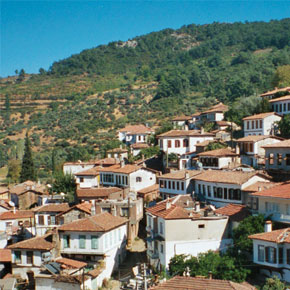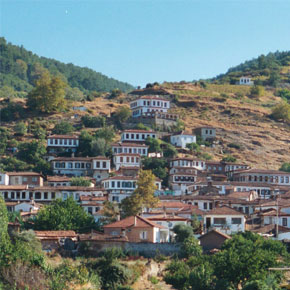Şirince, Turkey
A Greek village in Turkey
Viewed from the distance, as the minibus winds up through the olive groves and orchards, Şirince (pronounced Shirinjay) looks something like a quaint collection of old railway carriages tossed against the hillside. On arrival though, it turns out to be something of a living museum and one of the finest remaining examples of an Ottoman village one is likely to come across in Western Turkey.
Amidst a natural amphitheatre of surrounding green, the ample, white-washed houses, with their shallow-pitched, pan-tiled roofs, huddle together haphazardly separated only by steep narrow passageways that wind between them. Their upper storeys, in characteristically Ottoman fashion, jut out over the alleyways while large, wooden-framed, rectangular windows open out onto the vineyards below. An atmosphere of quiet dignity suffuses this haven of rural idyll.
In its former years, the village was inhabited by Greek Orthodox Christians – or “Rum” as they are known in Turkish (presumably on account of their Christianity and an erroneous association with Rome). In 1923, however, as part of the huge population exchanges agreed between Greece and Turkey, the ‘Rum’ were forced out of Anatolia and dispatched to Greece – a country entirely foreign to them. Their abandoned villages were to be given to Greek-speaking Muslims arriving from Salonica but in practice, the refugees refused to settle in these abandoned villages. Believing they must be haunted, they preferred to find shelter in the towns and over the course of time, the empty Greek villages simply fell to pieces.Thankfully though, Şirince was a rare exception, and today, besides the flocks of goats and heavily laden donkeys driven through the cobbled passageways by the migrants’ grandchildren, the streets are filled with stalls selling local handicrafts. Some of the hand-embroidered tablecloths are surprisingly inexpensive and would make excellent presents to take home. Other wares on sale include locally produced olive oil, a delicious bread made from chick peas and, depending on the season, everything from figs to peaches to bunches of dried thyme. Look out too for the bags of what looks something like crushed orange lentils – tarhana, from which the Turks make a spicy soup.
The Greek history of Şirince also explains the presence of a charming church in the village. It dates from the early nineteenth century and is presently being restored.
Apart from the splendid architecture and local handicrafts, the other attraction that draws the visitor to Şirince must surely be the cheap and plentiful food. My recommendation would be to try one of the delicious gözleme – a kerchief-sized sheet of wafer-thin pastry folded over and filled to order with either potatoes, cheese, herbs, mincemeat or aubergines. Though typical of Turkey, as a distinctly village type of food, gözleme is often difficult to find in cities and the coastal resorts, but it makes an excellent and quite filling snack and Şirince is full of little tea-gardens where you can sit and order them. As a refreshing accompaniment, I would recommend an ayran: a flavoursome savoury yoghurt drink. A lunch of gözleme and ayran will set you back somewhat less than a pound.
The other important legacy that the Greeks bestowed on the village is still very much in evidence wherever you wander: the art of winemaking. Wine is produced in several parts of Turkey – most notably in Cappadocia and Thrace – but to find wine being made on the eastern shore of the Aegean comes as something of a surprise. The fine, local Karaçali grape, however, produces a full, fruity tasting wine which the visitor will have ample opportunity to taste as they wander round Şirince. There are several excellent wine houses where you can buy wine by the glass and sample whatever you might later choose to buy.
As you wander the streets, ponder too the village’s name, which is something of a curiosity. The village was apparently once named “Çirkince’ – which means ‘uglily’ in Turkish – and local legend has it that the village was founded by people fleeing from feudal lords. In order to conceal the beauty of their new village, whenever people asked them how they lived now, they would reply simply: “uglily”. At some point in the village’s history, though, the name changed to Şirince – or ‘charmingly’.


